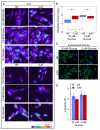Metabolic alterations in lung cancer-associated fibroblasts correlated with increased glycolytic metabolism of the tumor
- PMID: 23475953
- PMCID: PMC3686965
- DOI: 10.1158/1541-7786.MCR-12-0437-T
Metabolic alterations in lung cancer-associated fibroblasts correlated with increased glycolytic metabolism of the tumor
Abstract
Cancer cells undergo a metabolic reprogramming but little is known about metabolic alterations of other cells within tumors. We use mass spectrometry-based profiling and a metabolic pathway-based systems analysis to compare 21 primary human lung cancer-associated fibroblast lines (CAF) to "normal" fibroblast lines (NF) generated from adjacent nonneoplastic lung tissue. CAFs are protumorigenic, although the mechanisms by which CAFs support tumors have not been elucidated. We have identified several pathways whose metabolite abundance globally distinguished CAFs from NFs, suggesting that metabolic alterations are not limited to cancer cells. In addition, we found metabolic differences between CAFs from high and low glycolytic tumors that might reflect distinct roles of CAFs related to the tumor's glycolytic capacity. One such change was an increase of dipeptides in CAFs. Dipeptides primarily arise from the breakdown of proteins. We found in CAFs an increase in basal macroautophagy which likely accounts for the increase in dipeptides. Furthermore, we show a difference between CAFs and NFs in the induction of autophagy promoted by reduced glucose. In sum, our data suggest that increased autophagy may account for metabolic differences between CAFs and NFs and may play additional as yet undetermined roles in lung cancer.
©2013 AACR.
Figures






References
-
- Albini A, Sporn MB. The tumour microenvironment as a target for chemoprevention. Nature reviews Cancer. 2007;7(2):139–47. Epub 2007/01/16. doi: 10.1038/nrc2067. PubMed PMID: 17218951. - PubMed
-
- Hanahan D, Coussens LM. Accessories to the Crime: Functions of Cells Recruited to the Tumor Microenvironment. Cancer cell. 2012;21(3):309–22. Epub 2012/03/24. doi: 10.1016/j.ccr.2012.02.022. PubMed PMID: 22439926. - PubMed
-
- Cirri P, Chiarugi P. Cancer-associated-fibroblasts and tumour cells: a diabolic liaison driving cancer progression. Cancer metastasis reviews. 2011 Epub 2011/11/22. doi: 10.1007/s10555-011-9340-x. PubMed PMID: 22101652. - PubMed
-
- Ostman A, Augsten M. Cancer-associated fibroblasts and tumor growth--bystanders turning into key players. Current opinion in genetics & development. 2009;19(1):67–73. PubMed PMID: 19211240. - PubMed
-
- Erez N, Truitt M, Olson P, Hanahan D. Cancer-Associated Fibroblasts Are Activated in Incipient Neoplasia to Orchestrate Tumor-Promoting Inflammation in an NF-kappaB-Dependent Manner. Cancer cell. 17(2):135–47. PubMed PMID: 20138012. - PubMed
Publication types
MeSH terms
Substances
Grants and funding
LinkOut - more resources
Full Text Sources
Other Literature Sources
Medical

